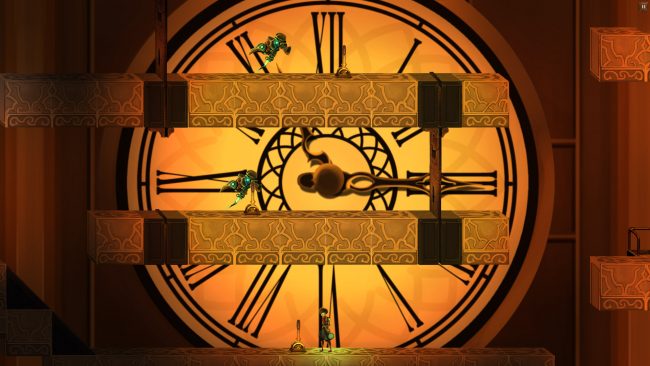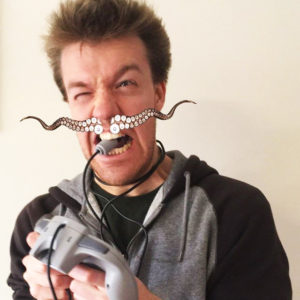
There’s always a lot of excitement that comes with finding an indie game that does something weird and different. Games like Undertale and Axiom Verge remind us that thinking outside the box can make for hours of delight. However, not all games nail that strange and astonishing creativity, perhaps lacking the development an idea so deserved and making do with ‘good enough’. Clockwork is, unfortunately, one of the indies that didn’t quite make the cut, harbouring some good ideas inside the clunkiness of its execution.

You play as Atto, a mechanical boy with a penchant for fixing things. One day, his watch wakes up and starts talking to him, calling herself Milli, and grants him the remarkable ability to time travel. Now, I’d love to tell you more about what happens in the game or why we’re pulling all these levers, but I don’t have the damn foggiest idea what’s going on in this game. There’s a lot of dialogue but no substance or explanation, so the story feels like filler before the next puzzle even though it keeps getting in the way. Lack of motivation aside, the game has some intriguing ideas, like puzzles based around time travel.
As the name would have you believe, Clockwork is all about making sure all the pieces of the puzzle work together. To that end, you have the ability to travel back to a point in time and influence what happens in the future. Your previous selves will trigger devices as you run through the newly opened doorway, while your other previous iterations deal with the robot mosquito out to kill you. It’s like Limbo and Braid had a lovechild, but, uh, the child isn’t quite what you’d hoped for. The potential for interesting puzzles is drool-inducing, but most of the time you’ll be frothing at the mouth in frustration.

While the core idea fueling Clockwork is sound, its execution is more Movado than Rolex. The controls are somewhat limp, bordering on the clunkier end of the spectrum, and were often the main reason I couldn’t enjoy a given level. It’s especially infuriating when you already know the solution but can’t execute it because the controls get in the way. You need to jump to a higher level, but Atto’s floatier than a bacterial infection, which doesn’t help with the precision required to pull off the jump. He’s slow as all hell too, and Milli’s no Sonic the Hedgehog, so you’ll spend most of your time waiting for the game to match your pace.
For a game so focused on time travel, there’s a hell of a lot of waiting. You’ll be waiting on past selves to do what you need, waiting on enemies, waiting on lifts, everything just moves so slowly. Milli can help out by exiting the watch and floating around, but she controls worse than Atto and moves at a lethargic pace. The result is a constant annoyance at the game not to be faster, because I know what needs to be done, I just need to wait for everything else to catch up. Of course, the game doesn’t make it easy to set any pace because the camera is figuring out how important your personal space is to you.

One of the key things puzzle games have to nail is what you can see at any given time, but Clockwork misses the mark. The camera is always way too close, so you’ll have to incite Milli’s aid to see anything around the level, including what pulling a particular lever did. Not seeing an immediate response to stepping on a pressure plate isn’t bad, but I shouldn’t have to spend 10+ seconds floating as Milli to figure out what I just activated. This hinders your ability to connect the dots almost as much as it takes away from the otherwise gorgeous visuals.
The game may leave much to be desired, but the art of the game is nothing short of wondrous. Levels are one of three possible themes, each with their own look and enemy variants. The game will sometimes (i.e., rarely) zoom out to reveal a mechanical vista or run down slum, and it’s evident where the most effort has gone. However, as much as the game is beautiful to look at, this style makes it difficult to figure out where anything is.

As pleasant as it is to see these hand-drawn characters in motion, the foreground tends to blend in a little too well into the environment. Levers and ladders are not clearly interactable, and sometimes making them out against the backdrop is a puzzle in of itself. The lighting sometimes makes it almost impossible to see where platforms start or end, especially in Poisonville’s dark areas. However, none of this compares to the part of the game that got to me the most.
The bugs. I get that this isn’t another huge company’s product, but there comes the point where you have to question how and why the game was released in this state. During the first boss battle, I would climb down a ladder and die immediately. A box would fall onto a moving lift but stay in the same spot, eventually falling into the infinite void because friction is probabilistic now. The worst one was when my ability to activate time portals, the things you use to jump back in time, just stopped working. It’s this lack of polish and attention to seemingly minor details that bring the game down, and because of that, it’s just not very enjoyable to play.

There’s lots of potential in Clockwork’s mechanics, but it’s brought down by clunky execution and lack of polish. Some good ideas are floating around in the game, but as far as playability is concerned, you’re better off finding another game to scratch your temporal itch. It’s a reminder that not all indie games are immediately good because of their independent status despite flaunting interesting concepts. Ah well, there’s always the next game to try something different.











